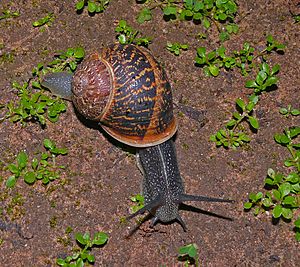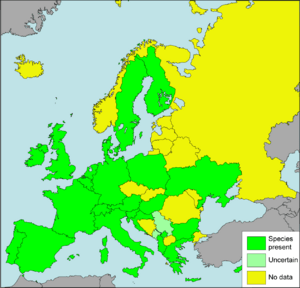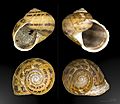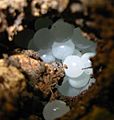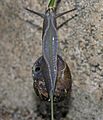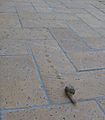Cornu aspersum facts for kids
Quick facts for kids Cornu aspersum |
|
|---|---|
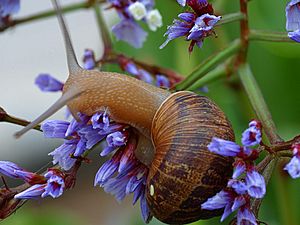 |
|
| Garden snail (Cornu aspersum) on Limonium | |
| Conservation status | |
|
NE
|
|
| Scientific classification | |
| Kingdom: | |
| Phylum: | |
| Class: | |
| (unranked): |
clade Heterobranchia
clade Euthyneura clade Panpulmonata clade Eupulmonata clade Stylommatophora informal group Sigmurethra |
| Superfamily: |
Helicoidea
|
| Family: | |
| Genus: |
Cornu
|
| Species: |
C. aspersum
|
| Binomial name | |
| Cornu aspersum (O. F. Müller, 1774)
|
|
| Synonyms | |
|
Helix aspersa Müller, 1774 |
|
The garden snail is a common land snail known by its scientific name, Cornu aspersum. For a long time, it was called Helix aspersa. This snail is often seen in gardens and can sometimes be considered a pest.
Garden snails are originally from Europe. However, they have spread to many other parts of the world. They look a lot like the Roman Snail (Helix pomantia), but they are usually smaller.
What Garden Snails Eat
Garden snails are herbivores. This means they mostly eat plants. They munch on leaves, flowers, and fruits. Sometimes, they can cause damage to garden plants.
How Garden Snails Reproduce
Snails are quite special because they are hermaphrodites. This means each snail has both male and female reproductive organs.
While a snail can technically reproduce by itself, they usually mate with another snail. After mating, both snails can lay eggs. They lay their eggs in moist soil. These eggs then hatch into tiny snails.
Images for kids
-
A Cornu aspersum on a white mulberry leaf in Johannesburg, South Africa.
See also
 In Spanish: Caracol común de jardín para niños
In Spanish: Caracol común de jardín para niños


